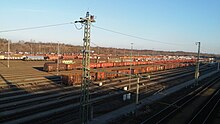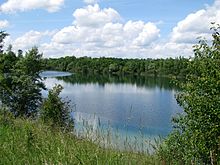Ludwigsfeld (Munich)
Ludwigsfeld is the westernmost part of the district in the city district 24 Feldmoching-Hasenbergl in the north-west of Munich , it is intersected by the A 99 with the Munich-Ludwigsfeld junction . The northern part mainly includes the Ludwigsfeld settlement east of Dachauer Strasse opposite the MAN site and south of Karlsfelder Strasse almost to Lake Feldmochinger . In the south there is an industrial and residential area along the street "Auf den Schrederwiesen" and on the western side of Dachauer Straße the landscape lake Allacher Lohe and the easternmost areas of the Allacher Forest .
description
3,395 people live in Ludwigsfeld [2015]. Around 20 nationalities live together in the settlement, including 140 former forced laborers and many of their descendants. The Ludwigsfeld estate is therefore an example of successful integration beyond Munich.
At Rubinstrasse 14 is the Tibetan Buddhist Kalmuck Temple, Germany's oldest Buddhist temple, at Achatstrasse 14 is St. Michael , a place of worship of the Russian Orthodox Church.
The Karlsfelder Straße connects Munich with the northwestern municipality of Karlsfeld .
history
In 1801, at the instigation of the then Bavarian Elector Maximilian IV. Joseph (from 1806 first Bavarian King Maximilian I Joseph), the reclamation of the Dachau Moos began. One of the villages that were founded was named after the Crown Prince and later King Ludwig I. Ludwigsfeld . On March 16, 1802, Minister of State Maximilian Graf von Montgelas laid the foundation stones for the first buildings of the settlement along an old Roman road on Dachauer Landstrasse . Each colonist received a house, garden, fields, meadows and forest.
Ludwig married Therese von Sachsen-Hildburghausen in October 1810 . A horse race was also held on the occasion. This was the new edition of the so-called scarlet race , which had previously been held on the route between today's Stiglmaierplatz and the later municipality of Ludwigsfeld. This race on the occasion of the wedding of Ludwig and Therese on the later Theresienwiese was, together with the folk festival, which also took place at the time, the beginning of the world-famous Oktoberfest .
Ludwigsfeld developed quickly and was raised to an independent municipality in 1818. The mining of peat and the extraction of ice from the resulting ponds were the basis for Ludwigsfeld's prosperity.
Around 1890, the Bavarian Colonel Max von Lutz built a thoroughbred stud that in 1900 already comprised around 80 horses. From the 1930s to the 1970s, riding and jumping tournaments were held on the site. From around 1910, the gardening industry in Ludwigsfeld and in the neighboring settlements Fasanerie-Nord , Am Hart and Lerchenau experienced its first heyday.
In 1938, the independent community of Ludwigsfeld was incorporated into Munich against the will of most of the residents.
In 1939, the Deutsche Reichsbahn began building a high-performance shunting yard south of Ludwigsfeld am Allacher Forst . The Munich-Ludwigsfeld building goods station was built for this purpose from 1940 . In 1942, during the Second World War , the Deutsche Reichsbahn stopped construction work on the high-performance shunting yard.
In 1938, the production of aircraft engines began at the BMW plant in Allach , which had been built north of Ludwigsfeld in the Allacher Forest from 1936 onwards. In order to meet the needs of the BMW plant for workers, a whole system of camps for forced laborers, prisoners of war and prisoners from the Dachau concentration camp was created around the plant during the Second World War . In 1941 the company set up its own warehouse called Lager Ludwigsfeld opposite the factory on the eastern side of Dachauer Straße . To the east of this camp, beyond the Schwabenbächl in the area of today's Ludwigsfeld settlement , there was the Allach subcamp from March 19, 1943 until its liberation on April 30, 1945 , in which 20,000 prisoners were temporarily held. The so-called death march started from here on April 26, 1945 with a few thousand participants .
After the Second World War, the Allach subcamp became an internment camp and later an American material depot. In 1952, the Ludwigsfeld housing estate was built in the western part of the former subcamp.
From 1987, the Munich North marshalling yard was built on the site of the formerly planned high-performance marshalling yard , which was completed by 1991. The Munich-Ludwigsfeld station was used again as a building goods station and was shut down in 1991.
In 1990 the landscape lake Allacher Lohe was created as a service and fire water lake for the Munich North marshalling yard .
Between 1998 and 2000, new apartments and houses were built south and east of the Ludwigsfeld settlement. But even this was no reason for the city of Munich to pay more attention to this district. As the climax of its policy towards the unpopular "broken glass district", the state capital of Munich made such a small purchase offer that the federal government rejected it. PATRIZIA AG acquired the Ludwigsfeld estate in 2007 for EUR 10.5 million.
On July 22, 2007, the Ukrainian President Viktor Yushchenko visited Ludwigsfeld and sought talks with former Ukrainian forced laborers. The background to this visit was that his father was housed in this camp as a slave laborer during the war. At the same time, Joseph Ratzinger, who later became Pope Benedict XVI. , deployed there as a 16-year-old flak helper .
Ludwigsfeld is a place on the cultural history trails in Munich .
Infrastructure
The Ludwigsfeld -Fasanerie department of the Munich fire brigade has its fire equipment house in Ludwigsfeld .
Web links
- Ludwigsfeld settlement. Retrieved April 17, 2016 .
Individual evidence
- ↑ https://www.citypopulation.de/php/germany-munchen_d.php
- ↑ https://www.muenchen.de/rathaus/Stadtverwaltung/Kulturreferat/Stadtgeschichte/Kulturgeschichtspfade/kgp_24.html
- ↑ Return of the riders. In: sueddeutsche.de. September 3, 2017. Retrieved June 28, 2018 .
- ↑ Klaus-Dieter Korhammer, Armin Franzke, Ernst Rudolph: Turntable of the South. Munich railway junction . Hestra-Verlag, Darmstadt 1991, ISBN 3-7771-0236-9 , p. 158 .
- ↑ Photo documentation and history of the Ludwigsfeld train station on doku-des-alltags.de, accessed on October 2, 2016.
Coordinates: 48 ° 13 ' N , 11 ° 29' E





